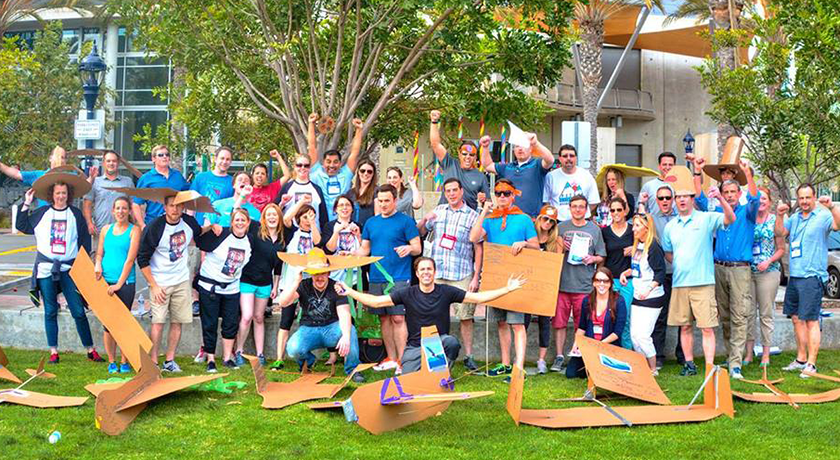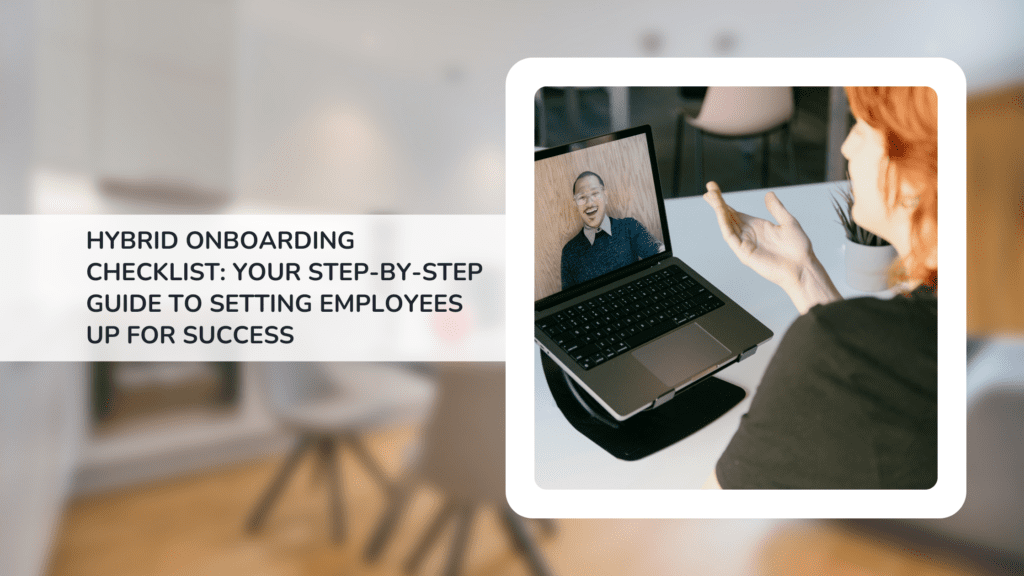Your company retreat should be just as exciting for employees as it is useful for your business. Here’s how to Plan a Successful, Unforgettable Company Retreat in 7 steps.
Updated: March 18, 2025
Planning a company retreat? The right approach can turn it into more than just a break from the daily grind—it can become a powerful catalyst for team connection, creativity, and alignment.
But without a clear roadmap, even the best intentions can fall flat. From logistical headaches to missed opportunities for impact, poor planning can turn a promising retreat into a costly misstep.
That’s why having a step-by-step plan is essential.
In this article, we’ll walk you through the seven key steps to planning a successful company retreat. Whether you’re planning your first retreat or looking to improve your next one, this guide will help you create an event that’s both meaningful and memorable.
Table of Contents
- 7 Steps to Plan a Company Retreat That Actually Works
- How to Balance Your Retreat Agenda with the Right Sessions to Ensure It’s Effective
7 Steps to Plan a Company Retreat That Actually Works

A company retreat isn’t just a break from work—it’s a strategic investment in your team’s productivity, morale, and collaboration. But without a clear plan, you risk throwing money at an event that feels aimless and unproductive.
Successful company retreat planning means thinking ahead. Every decision—from choosing a venue to structuring the agenda—needs to be intentional.
Here’s how to plan a seamless, results-driven retreat that your team will actually benefit from.
1. Set Clear Goals for Your Retreat
If you don’t know why you’re hosting a company retreat, your team won’t either. The best retreats serve a specific purpose that aligns with company objectives.
Some common company retreat goals include:
- Celebrating accomplishments and reinforcing company culture
- Building trust and improving team relationships
- Aligning teams on strategic goals and upcoming initiatives
- Encouraging creativity and problem-solving
- Boosting morale and preventing burnout
Decide on one primary goal or a few key priorities before making any logistical decisions. These goals will shape where you go, what’s on the agenda, and how you allocate your budget.
2. Assign Responsibilities and Build a Planning Team
Planning a company retreat is a big job, and one person shouldn’t handle it alone. Even companies with a dedicated event planner benefit from sharing responsibilities.
Divide retreat planning tasks among your team. Key areas to assign include:
- Venue and accommodations: Researching locations, booking spaces, and organizing lodging
- Travel logistics: Flights, transportation, and scheduling
- Meals and catering: Planning menus and handling dietary restrictions
- Agenda development: Structuring business sessions and activities
- Team building activities: Organizing exercises that align with retreat goals
At Outback Team Building & Training, we split retreat planning across multiple leaders to ensure every aspect runs smoothly.
3. Involve Your Team in the Planning
A retreat shouldn’t feel like a corporate mandate. If employees don’t see value in the event, participation will suffer. Get their input early so the retreat meets their expectations.
Send out a pre-retreat survey and ask about:
- Preferred locations
- Ideal retreat timing
- Types of team building activities they enjoy
- Topics or challenges they want to address
- Special considerations (accessibility, dietary needs, etc.)
When employees have a say in the planning, they’re more engaged and invested in the experience.
4. Set a Realistic Budget
Retreat costs add up fast, and budgeting should happen before you start making bookings. The average overnight retreat costs $300–$350 per person per day, covering accommodations, food, and activities.
A well-structured budget includes:
- Travel and transportation: Flights, gas, rental cars, or shuttles
- Venue and lodging: Hotel stays, retreat centers, or private rentals
- Food and beverages: Catered meals, group dining, snacks, and drinks
- Team building and activities: External facilitators, recreational outings, or workshops
- Contingency fund: Unexpected costs that inevitably come up
If costs are a concern, prioritize experiences over luxury. A high-end venue won’t compensate for a weak agenda or disengaged participants.
5. Choose the Right Venue
A great venue does more than provide a nice backdrop—it enhances the retreat’s success. The setting should align with your retreat’s objectives and make logistics easy for your team.
Key considerations include:
- Urban vs. remote locations: City settings offer more convenience, while remote venues promote deeper focus and team bonding
- Proximity to employees: Nearby locations minimize travel costs; destination retreats create a stronger “getaway” feel
- On-site vs. off-site lodging: Keeping employees together fosters stronger connections, but separate accommodations may be necessary for flexibility
For expert recommendations, check out The Top 20 Destinations in North America for Company Retreats to find the perfect spot for your event.
6. Pick the Right Time
Scheduling is one of the hardest parts of retreat planning. You won’t find a date that works for everyone, but careful planning can maximize attendance and engagement.
Consider the following when choosing your retreat dates:
- Workload impact: Avoid peak busy seasons so employees can fully participate
- Key stakeholders’ availability: Ensure decision-makers and leadership can attend
- Cost factors: Off-peak travel months often have lower rates on venues and flights
At Outback Team Building & Training, we plan retreats during slow sales periods to prevent disruption and ensure full engagement from employees.
7. Fine-Tune the Logistics
Overlooking logistics leads to avoidable headaches. Before finalizing your retreat, double-check every detail.
Retreat Logistics Checklist
- Transportation: Confirm flights, rental cars, and shuttle arrangements
- Meals and dining: Finalize menus, dining reservations, and dietary accommodations
- Accommodations: Secure room bookings and finalize guest lists
- Liability waivers: Determine if any retreat activities require signed waivers
- Packing list: Provide employees with a checklist of what to bring
- Special accommodations: Ensure accessibility for employees with mobility needs or medical concerns
Taking care of these details ahead of time ensures a smoother experience for everyone.
How to Balance Your Retreat Agenda with the Right Sessions to Ensure It’s Effective

What Makes a Great Agenda?
The best company retreats have a varied agenda, with lots of different types of business sessions and activities planned for employees.
What Should You Actually Do at Your Company Retreat?
To answer this question, you’ll want to refer back to your original goals for the retreat and come up with a schedule that best helps your group meet them.
After years of experimentation, our team has discovered that the best retreat agendas usually combine:
- Business sessions
- Team building
- Professional development
- Free time
Business Sessions
Just because you’re away from the office doesn’t mean you can’t get some serious work done at your company retreat.
Some popular business sessions can include:
- State of the Nation Address: Kick things off by having a company leader give a general update on the status of the business and their vision for the future.
- Product Launches: Get employees excited about new and upcoming customer products by unveiling and demoing them for the first time.
- Interdepartmental Meetings: Encourage communication by having sessions where different departments get to meet and talk through some of their challenges with each other.
- New Company Initiatives: This is a great opportunity to launch new employee engagement and workplace culture programs.
Team Building Activities
You can also use your company retreat as an opportunity to bond and build closer relationships with your team using team building activities.
Hollywood Murder Mystery

An up-and-coming actress has been found dead in her hotel room the morning after an awards show. Now, you and your team need to channel your inner detectives as you review the evidence, assess potential suspects, and determine the method, motive, and murderer in the crime.
Wild Goose Chase

If you love to get out into the great outdoors, explore, and have fun, then you’re going to love this.
One of our most popular events, Wild Goose Chase, is a scavenger hunt team building activity that will get you outside to explore and tackle photo and video challenges with your friends.
Each challenge will be worth a certain amount of points. And for each challenge you complete, you’ll get to watch where you stand against other teams on a real-time leaderboard.
You might bump up against challenges like:
- Take the Stage: Search for a stage (or similar) and record a 5-second video of your team performing a popular song on stage
- If By Land or by Sea: In water or on land, in a slip or in a moat. Take a photo of your whole team standing in a boat or on a bridge above water
- Every Day I’m Jugglin’: Find a friend from another team who can juggle 3 or more objects and record a 5-second video of them in action
- You’ve Got Balls: Snap a photo with at least three different types of sports balls in it, somewhere outside in a public place such as a sports field or playground
Believe us when we say that this can get a little competitive!
Jeoparty Social

With Jeoparty Social, your team will get to step into their very own Jeopardy-style game show experience – equipped with a buzzer, a professional actor as your host, and an immersive game show platform. Between each round of Jeopardy, your team will participate in social mixer challenges.
Get ready to test your trivia knowledge, hit that buzzer as fast as you can, stack up points for your team before time runs out, and wager a little bit (or a lot) in a round of Final Jeoparty to wrap it all up.
This activity is also available in a virtual format for remote teams.
Clue Murder Mystery

You’ve probably never heard of a man named Neil Davidson. But your group will need to come together to solve the mystery of his murder by analyzing clues, resolving challenges, and figuring out who had the means, motive, and opportunity to commit a deadly crime.
This activity will challenge you and your group to approach problems analytically, read between the lines, and use critical thinking in order to identify a suspect and deliver justice.
This activity is also available in a virtual format for remote teams.
Charity Bike Buildathon

Split into teams to build, decorate, and put together an advertising campaign for children’s bicycles. After each group has presented their bike, you get to donate them all to a charity of your choice!
And if you have remote employees joining in, you can also enlist virtual team building activities so that they can partake in the fun.
Professional Development
With everyone together, your company retreat is the perfect time to learn new skills and practice them with your colleagues.
Emotional Intelligence

Develop the self-awareness of your group with a skill development session, that doubles as a team bonding exercise.
Practical Time Management

Help your coworkers make better use of their time with an interactive training workshop.
Clear Communication

Practice better communication skills with a hands-on experiential learning program.
Authentic Leadership

Everyone in your organization has the opportunity to think and act like a leader. Uncover your team’s hidden leadership skills with a half-day training session.
Free Time
One of the biggest mistakes you can make when planning your company retreat is not giving employees enough free time between sessions. If this is your first year planning a company retreat, it can be tempting to pack the schedule full with different things going on all the time.
But sometimes, less is more.
Not only is free time a great opportunity for employees to catch up on some work, but it can also encourage more socializing and help people avoid feeling “burned out.”
A good rule of thumb: for every hour of business sessions at your company retreat, you should have at least half an hour of free time.
So, if you have a three-hour business session in the afternoon, you might want to offer a minimum of 45-minute breaks before and afterward.
A great company retreat doesn’t just happen—it’s the result of smart planning, clear goals, and thoughtful execution. When every detail aligns with your team’s needs and your company’s vision, you create more than just an event—you create momentum. Use these seven steps to plan a retreat that energizes your people, strengthens your culture, and sets the stage for real results.
Need Help Planning Your Company Retreat?
Get in touch with our Employee Engagement Consultants to learn how team building and professional development sessions can take your next company retreat to another level.



